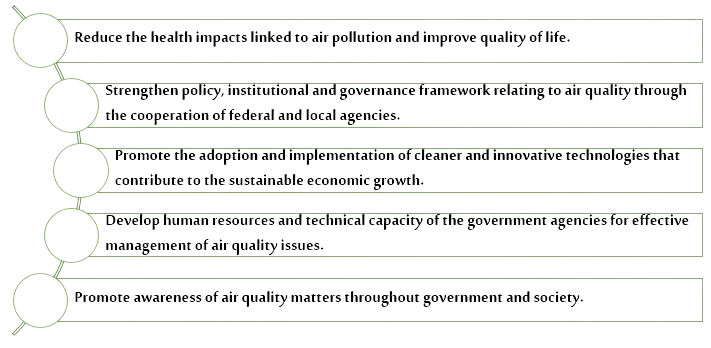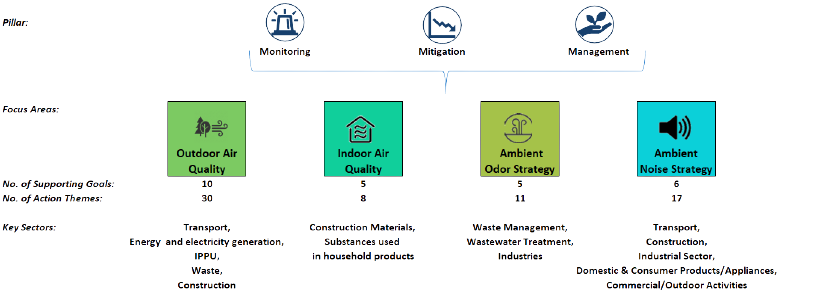At a Glance
| Strategic Outcomes | SO4 Improved air quality |
|---|---|
| Start Date | Q1 01 JAN 2020 |
| End Date | q4 31 DEC 2022 |
| Funding Source | Earmarked |
| Actual Budget (USD) | 653,000 |
| Budget Percentage | 89% |
| Actual Expenditure (USD) | 578000 |
| Status | Complete |
| GGGI Share (USD) | |
| Poverty and Gender Policy Markers | |
| Name of Client (Lead/Prime implementer if GGGI is part of a consortium) | Ministry of Climate Change and Environment (MOCCAE) |
| Participating Organization (Funding/donor) | Ministry of Climate Change and Environment (MOCCAE) |
| Name of consortium members, if any | |
| Thematic Area |
|
GGGI Project Code : AE08
Project Manager and Staff +
Project Overview
The UAE has long recognized the important role air quality plays in supporting an overall healthy and sustainable life for its inhabitants. Consequently, the UAE afforded air quality a high priority and a key performance indicator (KPI) under its National Agenda leading to its Vision 2021 and will similarly recognise air quality in the UAE’s Centennial 2071 Plan objectives, which place a strong emphasis on a high quality of life and sustainable economy.
The importance of air quality is also recognised in the National Environmental Policy of the UAE . It sets “improving air quality” as one of its eight priorities and specifies goals for it. In doing so, it adopts an interpretation of air quality which explicitly recognizes four areas of air pollution namely:
| Outdoor air pollution – frequently associated with so-called ‘classical’ air pollutants such as nitrogen dioxide (NO2), sulphur dioxide (SO2), ozone (O3) and particulate matter, as well as a variety of organic and inorganic pollutants. | |
| Indoor air pollution – caused by a very broad range of sources, including dampness / mould, cleaning / construction related chemicals, tobacco / incense smoke and entrainment from outdoor pollution. | |
| Ambient Odors – a form of air pollution that can lead to decreased quality of life or sense of wellbeing for members of the public, and exposures to odors can sometimes cause adverse health effects. | |
| Ambient noise – excessive ambient noise levels can pollute the atmosphere, causing annoyance and affecting peoples’ quality of life. The WHO considers environmental noise to be a public health threat as it has been acknowledged to cause adverse human health effects. |
The Strategy is thus expected to drive air quality improvements while also supporting the realisation of co-benefits and leveraging synergies across a range of related sectors. It was designed to align with and support other national thematic or sectoral strategies and consequently seeks to improve air quality in four areas: outdoor and indoor air quality, ambient odors and ambient noise. The strategy has five strategic objectives, these are set out below:

Based on extensive inter-ministerial consultation, assessment on existing policy, regulation, and institutional framework, as well as international benchmarking assessment, the UAE Air Quality Strategy is built upon three pillars:
- The Monitoring pillar relates to the actual measurement of air pollution and related parameters.
- The Mitigation pillar relates to a broad range of existing, planned and/or required actions that will be taken to reduce levels of emissions / pollutants, and also reduce exposure to these pollutants.
- The Management pillar relates to measures that will allow for interventions and initiatives to be effectively implemented, tracked, and controlled to achieve the overall goal of improved air quality.
The Strategy also defines four focus areas: Outdoor Air Quality, Indoor Air Quality, Ambient Odor, and Ambient Noise, each comprising several key priority sectors representing major sources of pollution and each with an overarching target and several supporting goals set across a range of action themes. This is summarised in the following chart.

Accordingly, the Strategy sets an overarching goal and numerous supporting goals for each of the focus areas, followed by proposed key action themes, targeted deliverables, responsible agencies, and the implementation plan until 2031. The list of overarching goals and supporting goals are summarized below.
Outdoor Air Quality
Reduce levels of outdoor air pollution and human exposure to pollutants to safeguard health and improve quality of life.
- Strengthen the institutional framework, human resource and technical capacity, and scope of government agencies to effectively monitor and manage outdoor air quality.
- Ensure that air quality is a key consideration during the development and implementation of strategic projects, and that it is acknowledged as an important factor for sustainable urban development.
- Reduce emissions arising from activities relating to the transport sector.
- Reduce emissions arising from activities relating to the electricity generation sector.
- Reduce emissions arising from activities relating to the industrial processes and product use (IPPU) sector and energy generation (not for electricity generation).
- Reduce emissions arising from waste sector activities and maximize environmentally beneficial opportunities for recovering energy from waste.
- Control and reduce emissions arising from construction sector activities.
- Improve understanding of key topics relating to outdoor air pollution through research and scientific studies.
- Improve awareness of outdoor air quality issues within government and society.
- Regional cooperation to manage and reduce the impacts of transboundary pollution.
Indoor Air Quality
Improve indoor air quality and reduce human exposure to pollutants to reduce risks to health and wellbeing.
- Strengthen the institutional framework, and human resource and technical capacity of government agencies to effectively monitor and manage indoor air quality and to mitigate indoor air pollution.
- Have access to a compendium of standards setting-out relevant and appropriate use and/or low-emission specifications for construction materials, substances used in furniture and decoration and cleaning products.
- Have access to a compendium of standards / codes of practice on building design and maintenance
- Improve understanding of key topics relating to indoor air pollution through research and scientific studies.
- Improve awareness of indoor air quality issues within government and society.
Ambient Odor Strategy
Reduce human exposure to ambient odors to improve quality of life and minimize the risk of potential adverse health effects
- Strengthen the institutional framework, human resource and technical capacity of government agencies to effectively monitor and manage odor.
- Reduce odor emissions arising from waste management and disposal, and wastewater treatment activities.
- Reduce odor emissions arising from oil and gas sector and fuel storage and distribution activities.
- Reduce odor emissions arising from industrial and manufacturing activities.
- Improve awareness of odor issues within government and society.
Ambient Noise Strategy
Reduce the levels of ambient noise and human exposure to excessive noise
- Strengthen the institutional framework, human resource and technical capacity of government agencies to effectively monitor and manage ambient noise
- Reduce noise impacts arising from transport sector sources
- Reduce noise impacts arising from construction sector sources
- Reduce noise impacts arising from industrial sector sources
- Control noise from domestic and consumer products and appliances
- Improve awareness of ambient noise issues within government and society
Project Results
Impact
Improved air quality and environmental health in the UAE
Outcome
Strengthened national capacity to lead and coordinate the actions from federal and local institutions for streamlined monitoring and management of air quality and effective mitigation of air pollution.
Output
- Final draft of the National Air Quality Strategy in compliance with the Cabinet memo requirements.
- Governance mechanism for implementing UAE Air Quality Strategy.
- Sectoral emission data collection and analysis in preparation for the 2nd National Air Emissions Inventory.
Privacy Overview
| Cookie | Duration | Description |
|---|---|---|
| cookielawinfo-checkbox-analytics | 11 months | This cookie is set by GDPR Cookie Consent plugin. The cookie is used to store the user consent for the cookies in the category "Analytics". |
| cookielawinfo-checkbox-functional | 11 months | The cookie is set by GDPR cookie consent to record the user consent for the cookies in the category "Functional". |
| cookielawinfo-checkbox-necessary | 11 months | This cookie is set by GDPR Cookie Consent plugin. The cookies is used to store the user consent for the cookies in the category "Necessary". |
| cookielawinfo-checkbox-others | 11 months | This cookie is set by GDPR Cookie Consent plugin. The cookie is used to store the user consent for the cookies in the category "Other. |
| cookielawinfo-checkbox-performance | 11 months | This cookie is set by GDPR Cookie Consent plugin. The cookie is used to store the user consent for the cookies in the category "Performance". |
| viewed_cookie_policy | 11 months | The cookie is set by the GDPR Cookie Consent plugin and is used to store whether or not user has consented to the use of cookies. It does not store any personal data. |